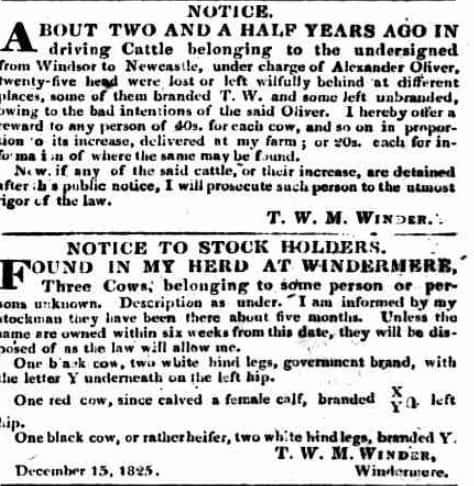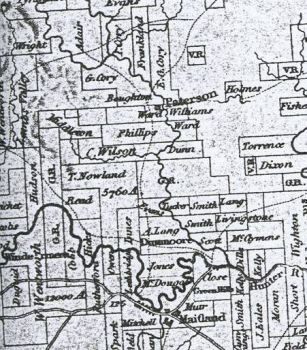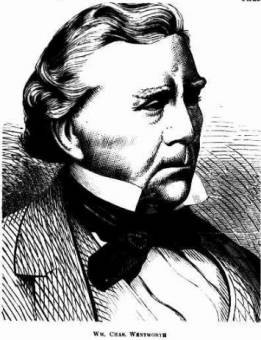Thomas Winder and William Wentworth
Windermere - Map 2
Thomas White Melville Winder
Thomas W. M. Winder was born in London. Before coming to Australia he was a captain in the Merchant Navy.He arrived in Sydney on the Frederick in 1817. He was a merchant, however abandoned trading after sustaining financial losses in a deal with Captain Ritchie, who failed to bring a promised cargo from Calcutta.
He was granted a large allotment on the corner of Bligh and Hunter Streets Sydney where he built a store house, advertising his goods as early as May 1818.
In partnership with Samuel Terry, Winder established a water mill for grinding flour at Botany Bay.

Land Grants
In the early 1820's Thomas Winder received several grants of land at the Hunter river. He was granted 760 acres on Hunter River on 31 October 1821.In April 1823 he accompanied Lieut. William Hicks to the Hunter. After this Hicks was granted 1120 acres which he named 'Melville' and Winder was granted a further 2000 acres.
Thomas Winder acquired by purchase, 320 acres from Luke Dillon A grant of 2000 acres was transferred to Winder by Henry Hawes and by 1828 he owned 7,400 acres of land as well as allotments in Maitland.
About the middle of 1823 Winder sent his cattle from Windsor to the Hunter by the Bulga track and 25 head were lost on the way. Alexander Oliver was later sentenced to 14 years transportation for cattle theft. When Windermere was actually built is not known however Allan Cunningham mentions it in his Journal in 1825 -Maitland Mercury Jun 1946 Early Times Recalled At “Windermere”
Thomas Winder and his family were in residence at Windermere by the time the above notices were placed in The Australian in December 1825, although perhaps not yet in the sandstone convict built Windermere House
William Edward Riley, who described his journeys around New South Wales in 1830 and 1831 in a Journal came to Winder's "thinly wooded and undulating grazing country which terminates in extensive tracts of cleared and cultivated land".
Mr. Winder's house stands at the centre of his wheatfields on rising ground. Mr. McLeod's cottage and farm offices are visible on the opposite bank of the river abot two miles, thus giving an air of neighbourliness to the scene seldom observable in the distant districts, where settlers are generally at long intervals of many miles of country. Mr. Winder, whose establishment bears the mark of affluence and prosperity is considered one of the wealthiest. He already possesses considerable property independent of his farm which embraces about 5000 acres. He must have expended a large sum in clearing the land now laid out in wheat fields and artificial grasses, to say nothing of that expended in buildings and would be a considerable loser if the estate were put up for sale at the present time. Royal Australian Historical Society JOURNAL AND PROCEEDINGS. Vol. XXXII. 1946. Part IV. The Journals of William Edward Riley.p. 241

Lord Liverpool Packet
In partnership with George Williams, Thomas Winder owned the famous cutter Lord Liverpool. Captain Alexander Livingstone of Bowthorne was master of the Lord Liverpool for many years. T.W.M. Winder also owned the Currency Lass and the St. Michael storeship.Family
Thomas Winder married Ellen Johnson in 1819. They had nine children together. Their daughters were Jessie, Ellen, Ann, Mary, Agnes and Fanny. They became known as 'The Roses of the Hunter'Jessie married Wakefield Simpson.
Ellen married Robert Richard Hungerford.
Ann married John Becher Hungerford in 1839.
Agnes married William Hungerford,
Fanny married George Jean de Winton of 99th regiment at North Brisbane in 1847.
Read about the 'Roses of the Hunter' - Maitland Mercury 26 April 1881
Convicts Assigned to Windermere Estate
A few of the many convicts who were assigned to work at the estate when it was owned by Thomas Winder were:Joseph Branch arrived on the Malabar assigned in 1824
Richard Beal arrived on the Sesostris assigned in 1828.
William Way arrived on the Norfolk assigned in 1828.
John Sheehan arrived on the Baring assigned in 1828.
William Ashton arrived on the Sesostris assigned in 1828
Between 1832 and 1833 the following convicts were assigned:
George Ruddle
John Woodfield,
Henry Smith,
James Kirkwood,
John Cookham,
William Graham,
James Boland,
John Connolly
Joseph Quarman
Free immigrants who were employed at Windermere included Francis Carding who arrived on the Surry in 1828 and William Belcher who arrived on the Isabella.
Find out more about the family of Thomas Winder and the convicts who were assigned to Windermere
William Charles Wentworth

Image: Sydney Illustrated News 26 January 1888
William Charles Wentworth was the son of Catherine Crowley and D'Arcy Wentworth. Catherine Crowley was convicted at the Staffordshire Assizes in July 1788 of feloniously stealing 'wearing apparel' and was sentenced to transportation for seven years. She was sent to Australia on the convict ship Neptune in June 1790. Dr D'Arcy Wentworth, who also sailed in the Neptune acknowledged William as his son.
William C. Wentworth owned Vaucluse estate on the south side of Sydney harbour, and his father's estate Homebush as well as many sheep stations however he lived at Windermere estate for several months each year. It was he who later extended Windermere homestead into a thirty-room house. There were cellars, stables, coach house and a vineyard.[1]
Boiling Down Facility
Winder and Wentworth in partnership with Charles Nott established a boiling down facility for the manufacture of tallow at Windermere in the depression of the 1840's. They were advertising their establishment in the Maitland Mercury by August 1844.Vineyards
By 1847 William Wentworth had established the extensive vineyards at Windermere. He entered samples of Burgundy wine, sweet water wine, brandy and vinegar in the Hunter River Agricultural Society show in April 1847.Charles Nott
In 1848 the estates of Windermere were advertised for lease in small lots, with or without the magnificent Windermere House. Later, in 1851 the estate was purchased by Charles Nott.Peter Green
In 1868 the proprietor was Peter Green. He put the estate up for auction in that year. It was described as a magnificent estate situated within an hour's drive by road or fifteen minutes by train from West Maitland and comprising between 950 and 1000 acres, a considerable portion of which was of the richest alluvial character. There was a steam boiling establishment with a twenty horse power engine with pulverizer, bone crusher etc.Windermere House was considered a commodious family mansion with over thirty rooms and cellars, and the very best ideal of a gentleman's country residence; it was tastefully designed and elegantly finished in the best style of workmanship. The interior was in excellent order and condition, though the outside had unfortunately been neglected, the proprietor having bestowed more attention to home appliances than outward decoration, looking to substantial and lasting improvements to the general estate rather than outdoor embellishments. It was estimated that the original expense of the erection of the house must have exceeded £4000.
In addition, the outbuildings were most complete consisting of an eight-stall stable (two stories) built of brick, coach house, hay loft etc. with men's rooms all in excellent condition; and a spacious and cellar for wines 90 x 27 x 24 was in the course of being constructed. There were also between 13 to 15 acres of five-year-old vines in the vineyard and an orangery that covered 12 acres of land and contained from 1000 to 1200 luxuriant trees.
Charles Solomon Capp
Windermere was purchased by Charles Solomon Capp in 1870. The homestead burned down in a fire in 1882 and a new house was later constructed on the foundations of the old convict built mansion.Notes and Links
1). Windermere House - A Gracious Reminder of Bygone Days2). To help his father secure valuable sandalwood from a Pacific island William Wentworth joined a schooner as supercargo in 1814. He was nearly killed by natives at Rarotonga while courageously attempting to save a sailor whom they clubbed to death. The captain died, and Wentworth, with knowledge gained on his earlier voyage from England and no mean mathematical skill, brought the ship safely to Sydney [1]. The Sydney Gazette reported the tragedy on 22 October 1814....
On Thursday arrived the Cumberland colonial schooner, Mr. Goodenough master, from Islands to the Eastward of the Friendly Islands, which she from hence proceeded the 18th of January last, with a view of procuring sandal wood, but failing in that object, has brought a lading of a wood possessing the property of dying various shades of yellow. This they procured at the island of Loratonga, 16 leagues E of Tongataboo, the natives of which are of the Otaheitan complexion, and of similar manners, but taller and much better formed. On their first and second attempts to land, they were prevented by the natives, who attacked them with slings, from which they threw round stones 6 lbs. weight with surprising dexterity. They nevertheless effected a landing afterwards, and became very friendly with the natives, who were employed in procuring the wood, and paid as labourers for their assistance, in tomahawks, and other suitable articles. They continued a friendly intercourse until the 12th of August ; when John Croker one of the crew who had accompanied Mr Wentworth on shore, was assaulted and killed in his presence with a club so instantaneously and unexpectedly as to render Mr Wentworth's aid wholly ineffectual. As soon as he saw the unfortunate man knocked down, he drew and snapped his pistol at the assailant - but it missed fire ; and as there was no time for deliberation, he rushed forward to his assistance - but human aid was then of no avail, for his head was bruised to a mummy, and his corporal pains had ceased for ever. - Mr. W. having now only to provide for his own safety, took a pistol from the dead man's body, and menacing and menaced, made his way to his boat. In another quarter a similar assault had been made on others of the crew, who were on shore for provisions, and all massacred: these were William Travis, George Strait, and an Otaheitan, and Ann Butcher, an unfortunate woman who had gone from this port in the vessel, was killed at the same time, when ashore on a visit to some native women who had shewn her much kindness. Mr. Goodenough affirms it to be his opinion, that all the murdered persons were afterwards devoured, as they had seen a part of one that exhibited every appearance of its remaining a fragment of a cannibal festival.
3). Frank Scanlon (1906-1986) - History of Windermere, Cessnock Historical Society. Recorded 12 April 1985 - Discusses the origins of Windermere, a grant to Thomas White Melville Winder. Son of Arthur Leslie (Duke of Wellington) and Lady Mary Melville.
References
[1] Michael Persse, 'Wentworth, William Charles (1790 - 1872)', Australian Dictionary of Biography, National Centre of Biography, Australian National University, published first in hardcopy 1967↑
